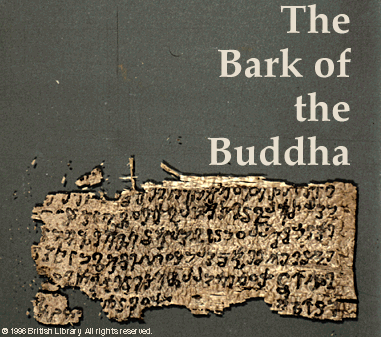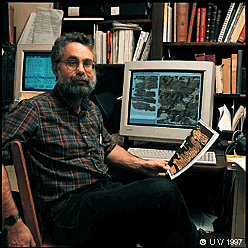

A frequent symbol in Buddhist literature is the rhinoceros. With his single horn, the rhinoceros stands out; unlike many other animals that travel in herds, the rhinoceros travels alone. The Buddha teaches that people should strive to be like the rhinoceros--wise, but separate from the world.
Scholarly pursuits, especially those involving seemingly esoteric subjects, often occur in splendid isolation, with ideas and theories being shared by perhaps a handful of like-minded individuals. But even isolated scholars run the risk of losing their comfortable obscurity when they make a discovery recognized as being of great importance. And, like the fate of the rhinoceros in modern Africa, they find their world touched on all sides by the distractions of civilization as they struggle to maintain their detachment.

Richard Salomon, UW professor of Asian languages and literature, recently found his career at such a watershed. The British Library contacted him in 1994 to ask if he was interested in looking at some very old Buddhist manuscripts that the library had recently acquired. Conservators at the library thought these might be among the oldest Buddhist documents ever identified--perhaps comparable in their significance to the Dead Sea Scrolls in Judeo/Christian tradition--but they needed someone with Salomon's expertise to verify their hunch. (Salomon is one of a handful of scholars in the world with the necessary background to read and understand such material.)
"My answer was `definitely,' " he recalls.
He was able to tap into a UW research fund, allowing him to visit the British Library the next summer. "Before that visit, I had a sketchy idea of what the library had acquired." As he pored over the fragile, birch bark scrolls, he saw that they were written in Gandhari, an ancient language of what is now northern Pakistan and eastern Afghanistan. He realized he was looking at fragments of perhaps 20 or so different texts, parts of scrolls that originally were five to six feet long.
"They allegedly were stored in clay water jugs, probably buried in a monastery. When the library received them they were shaped like a very old cigar that looked as if an elephant had sat on it. With the scrolls' general condition, unrolling them was a formidable problem," Salomon says.
The deputy director of the library described the scrolls as "fiendishly brittle material. The first question was, `Will these ever unroll or will they simply crumble into many pieces?' " The conservators put the scrolls in a bell jar overnight and allowed them to be slowly moistened. Then, holding their breath, one conservator used tweezers and began unrolling a scroll, while another moistened the scroll without saturating it.
Salomon spent three weeks at the library, "getting headaches and getting discouraged," trying to find a fragment of text that he could read well enough to relate to passages already well documented in Buddhist literature. From historical references in several passages, he was sure he was looking at words that were written in about the first century AD.
Although the Buddha died in India in 456 B.C., scholars have found no written record of his teachings dating from his lifetime or several centuries thereafter. If Salomon could confirm his hypothesis, he might well be looking at the oldest surviving Buddhist texts ever discovered.
Breakthrough: Linking the Lost Scrolls to Other
Buddhist Texts
Scholar Thrust into the
Limelight with Discovery of the Scrolls
Buddhist Doctrine from a Non-Buddhist
Send a letter to the editor at columns@u.washington.edu.